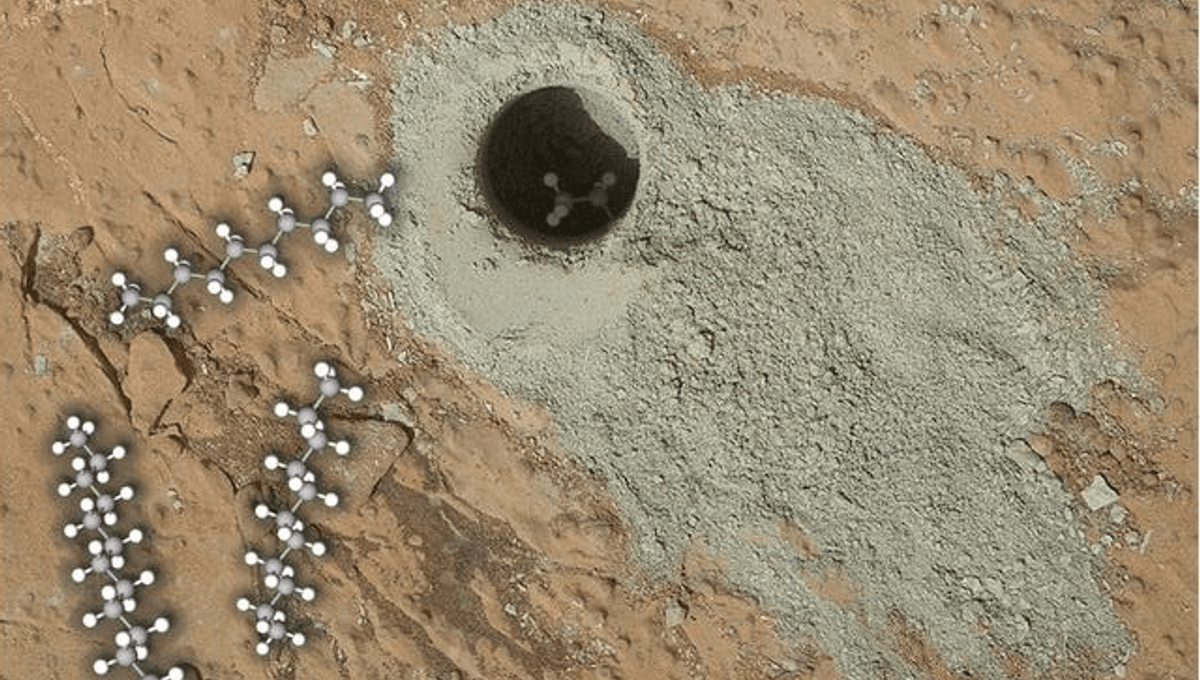
The Curiosity rover has found the largest organic molecules yet discovered on Mars within a Cumberland mudstone in Gale Crater. The mudstone is 3.7 billion years old, which is when the molecules, or their chemical predecessors, were first formed, so whatever made them is long gone. Molecules like this are made on Earth both through living and non-living processes, so the discovery is not proof Mars once hosted life, let alone that it’s still present. However, the find does show that if Mars had life in its early days, the products could have survived all this time.
ADVERTISEMENT
The term “organic” has very different meanings depending on who you are talking to. However a farmer or food-buyer might interpret it, to a chemist it simply means molecules containing carbon. The sixth element bonds easily to many things, so not all organic molecules require life to make them, and they’re often found in places where scientists cannot imagine life was ever present.
Still, complex organic molecules are the backbone of life on Earth, and we suspect elsewhere as well. When searching for life on Mars, where ancient life that has long since died out is a definite possibility, one big question has been how well evidence from those times would have survived.
In the 13 years Curiosity has been on Mars we have learned about the composition of Gale Crater by placing pieces of it in the Sample Analysis at Mars (SAM) instrument and performing chemistry experiments and mass spectrometry. In that time SAM has revealed the presence of organic molecules with up to six carbon atoms, including some that contain chlorine or sulfur.
By the standards of space probes, SAM is very sophisticated, but it lacks the capacity of an Earthly chemistry lab. Nevertheless, its operators have found ways to operate it beyond it original design. Concerned that oxygen present in other Martian chemicals might be oxidizing some of the molecules they were looking for, the operators experimented with a two-stage heating process.
Samples of the mudstone were heated to around 475°C (887°F), followed by cooling and then to around 850°C (1,572°F) in the presence of the chemical derivation agent, N-methyl-N-tert-butyldimethylsilyl-trifluoroacetamide (MTBSTFA) vapor.
When this double heating process was performed on one sample of Cumberland mudstone it produced a high concentration of chlorobenzene, an organic molecule whose six carbon atoms then represented the Martian record. However, researchers also noticed smaller quantities of long-chain organic molecules known as alkanes, specifically decane (C10H22), undecane (C11H24), and dodecane (C12H26).
ADVERTISEMENT
Contamination from molecules brought from Earth is a concern for any unusual SAM results, but the authors of a report on this analysis are confident that is not the case here, since they don’t get the same result with other samples.
The quantities of these molecules are tiny – 53 parts per billion (± 22 ppb) for undecane and even less for the others. Still, the heating process may have degraded the sample, so there might have been more initially.
High school chemistry may remind you that benzene’s carbon atoms form a ring, whereas alkanes are a long chain of carbon molecules with hydrogen hanging off them, so this is something new for Mars, not just a slight expansion on previous discoveries.
The authors think the alkanes are the product of the heating process, and probably were not present in the Martian rock. However, SAM would not have triggered the formation of a longer carbon chain, instead changing the atoms attached to the carbon spine.
ADVERTISEMENT
Molecules that might convert into these alkanes include undecanoic acid (CH3(CH2)9COOH), and other carboxylic acids, better known as long-chain fatty acids that make up cell membranes. Heat can convert these fatty acids to alkanes with one fewer carbon atom. Fatty acids with up to 13 carbon molecules are produced by non-biological processes on Earth. However, longer chains, such as oleic acids with 16 or 18 carbons, are considered a better indication of life. If oleic acids were present in the sample, and were turned to alkanes in the heating process, their products would not have been detected by SAM.
Consequently, while this work doesn’t show Mars once had life, it makes it more likely that if life did exist billions of years ago, any oleic acids and other long-chain fatty acids produced may have survived in rocks. Despite billions of years of exposure to radiation near the Martian surface and whatever chemistry has occurred in that time, if life did thrive in the Martian ocean, its products are likely to be waiting there for us to send a rover better equipped than Curiosity to detect them.
A rover might be more likely to make such a discovery than a crewed mission, where the risk of contaminating the samples with fatty acids brought from Earth would be far higher.
ADVERTISEMENT
Alternatively, if the Mars Sample Return Mission ever gets the go-ahead, we can hope Perseverance has sampled some equally interesting rocks.
The study is published in Proceedings of the National Academy of Sciences.
Source Link: Curiosity Finds Record-Breaking Organic Molecules On Mars Possibly Formed From Fatty Acids